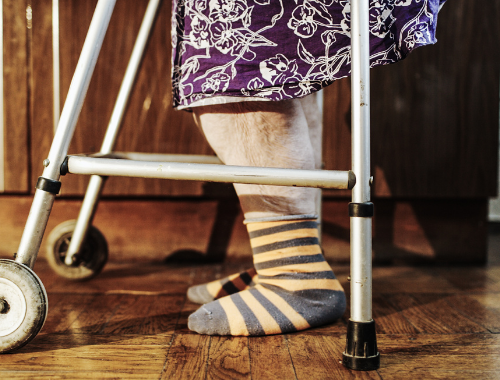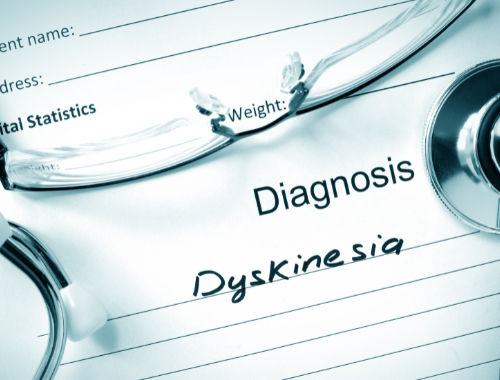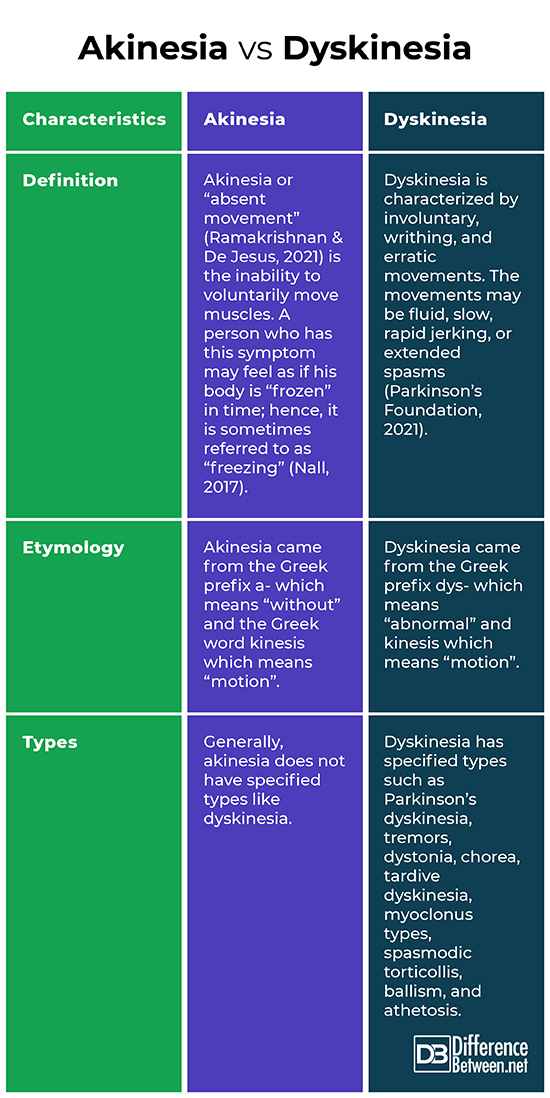Difference Between Akinesia and Dyskinesia
Both akinesia and dyskinesia can be disease symptoms (i.e., Parkinson’s disease) and involve movement difficulties. Regarding their treatments, these conditions may benefit from medication adjustments, deep brain stimulation, and physical therapy. Specifically, akinesia is the inability to voluntarily move muscles while dyskinesia is characterized by involuntary, writhing, and erratic movements. The following discussions further delve into their differences.

What is Akinesia?
Akinesia or “absent movement” (Ramakrishnan & De Jesus, 2021) is the inability to voluntarily move muscles. It came from the Greek prefix a- which means “without” and the Greek word kinesis which means “motion”. A person who has this symptom may feel as if his body is “frozen” in time; hence, it is sometimes referred to as “freezing” (Nall, 2017). The affected muscles may be in the face, legs, hands, or other body parts.
This condition can occur at any age. Physicians typically associate it with the later stages of Parkinson’s disease; 47% of more than 6,600 individuals with Parkinson’s disease reported freezing or akinesia as a symptom (Nall, 2017). Moreover, akinesia can be experienced by fetuses in the womb; fetal akinesia deformation sequence (FADS) is characterized by abnormal facial features, joint contractures, intrauterine growth restriction, and underdeveloped lungs (Jewell, 2018).
The symptoms of akinesia include difficulty in walking (i.e., “gait freezing”), muscle rigidity or feeling stiff in one or more muscle groups (usually beginning in the legs and neck; the facial muscles can also become rigid like a mask), and suddenly being unable for the feet to move appropriately when turning (Nall, 2017; Jewell, 2018).
The causes of akinesia include Parkinson’s disease, multiple-system atrophy, normal-pressure hydrocephalus, progressive supranuclear palsy (PSP) (characterized by gradual brain damage and inability to maintain balance when walking), hormone levels (i.e., low levels of thyroid hormone), genetic mutations (i.e., increased risk for fetal akinesia), and medication-induced Parkinson’s-like symptoms (Ramakrishnan & De Jesus, 2021; Nall, 2017).
Regarding treatments, they include stopping the medication (i.e., medication-induced Parkinson’s-like symptoms), and taking medications that can increase dopamine levels (Nall, 2017). Other remedies involve deep brain stimulation, physical therapy, eating fiber-rich foods, drinking plenty of water, meditation, and acupuncture (Jewell, 2018).

What is Dyskinesia?
Dyskinesia is characterized by involuntary, writhing, and erratic movements. It came from the Greek prefix dys- which means “abnormal” and kinesis which means “motion”. The movements may be fluid, slow, rapid jerking, or extended spasms (Parkinson’s Foundation, 2021).
The symptoms usually begin to show in the dominant hand or foot as minor shakes, tremors, or tics. They may vary according to the type. The following are some of the common types of dyskinesia ((Huizen, 2017):
- Parkinson’s dyskinesia (also known as Levodopa-induced dyskinesia)
Around 50% of individuals with Parkinson’s disease develop dyskinesia after being treated with levodopa within four to five years. The symptoms include wriggling, head bobbing, rocking, swaying, and fidgeting.
- Tremors
The rhythmic movements may be static or resting, kinetic or action and intention (during the movement of an upper body part), and postural (occur while a limb is not being moved and continue when moved).
- Dystonia
The sustained muscle contractions usually involve abnormal and repetitive twisting movements.
- Chorea
The continuous jerky movements are each held for a few seconds.
- Delayed Dyskinesia or Tardive Dyskinesia
Antipsychotic medications may cause stiff and jerky movements.
- Myoclonus Types
The severe spasms and jerks are usually repetitive and severe enough to be disabling.
- Spasmodic Torticollis
It is characterized by the abnormal twisting of neck and head.
- Ballism
It is characterized by violent flinging of the limbs.
- Athetosis
This is characterized by slow turning or bending writhing movements.
- Stereotypies and Tics
These are repetitive useless twitches; some professionals do not consider stereotypies and tics as a type of dyskinesia.
The treatments include adjusting medications, getting enough exercise, employing stress-management techniques, monotherapy, and deep brain stimulation (Wells, 2020).
Difference between Akinesia and Dyskinesia
Definition
Akinesia or “absent movement” (Ramakrishnan & De Jesus, 2021) is the inability to voluntarily move muscles. A person who has this symptom may feel as if his body is “frozen” in time; hence, it is sometimes referred to as “freezing” (Nall, 2017). On the contrary, dyskinesia is characterized by involuntary, writhing, and erratic movements. The movements may be fluid, slow, rapid jerking, or extended spasms (Parkinson’s Foundation, 2021).
Etymology
Akinesia came from the Greek prefix a- which means “without” and the Greek word kinesis which means “motion”. In comparison, dyskinesia came from the Greek prefix dys- which means “abnormal” and kinesis which means “motion”.
Types
Unlike akinesia, dyskinesia has specified types such as Parkinson’s dyskinesia, tremors, dystonia, chorea, tardive dyskinesia, myoclonus types, spasmodic torticollis, ballism, and athetosis.
Akinesia vs Dyskinesia

Frequently Asked Questions (FAQs)
What is akinesia and bradykinesia?
Akinesia is “absent movement” while bradykinesia is “slow movement”.
What is the difference between akathisia and akinesia?
Akathisia is the difficulty of staying still while akinesia is the inability to voluntarily move muscles.
What is the difference between tremor and dyskinesia?
One type of dyskinesia is tremors.
What is choreoathetosis?
Choreoathetosis is characterized by involuntary twitching or writhing. It is a combination of chorea which causes rapid unpredictable muscle contractions and athetosis which causes slow writhing movements (Anthony, 2018).
What is TD?
TD or tardive dyskinesia is characterized by stiff and jerky movements caused by antipsychotic medications.
Summary
- Both akinesia and dyskinesia can be disease symptoms, involve movement difficulties, and may benefit from medication adjustments, deep brain stimulation, and physical therapy.
- Akinesia is the inability to voluntarily move muscles while dyskinesia is characterized by involuntary, writhing, and erratic movements.
- Unlike akinesia, dyskinesia has specified types such as Parkinson’s dyskinesia, tremors, dystonia, chorea, tardive dyskinesia.
- Difference Between Hematoma and Melanoma - February 9, 2023
- Difference Between Bruising and Necrosis - February 8, 2023
- Difference Between Brain Hematoma and Brain Hemorrhage - February 8, 2023
Search DifferenceBetween.net :
Leave a Response
References :
[0]Anthony, K. (2018). Choreoathetosis. Healthline. https://www.healthline.com/health/choreoathetosis
[1]Huizen, J. (2017). What you need to know about dyskinesia. Medical News Today. https://www.medicalnewstoday.com/articles/319744
[2]Parkinson’s Foundation (2021). Dyskinesia. https://www.parkinson.org/Understanding-Parkinsons/Symptoms/Movement-Symptoms/Dyskinesia
[3]Ramakrishnan, S. & De Jesus, O. (2021). Akinesia. StatPearls. https://www.ncbi.nlm.nih.gov/books/NBK562177/
[4]Image credit: https://www.canva.com/photos/MADAvfjKtck-diagnostic-form-with-diagnosis-dyskinesia-and-pills-/
[5]Image credit: https://www.canva.com/photos/MAEqRFQ4pvQ-elderly-woman-going-slowly-with-the-help-of-walker/
